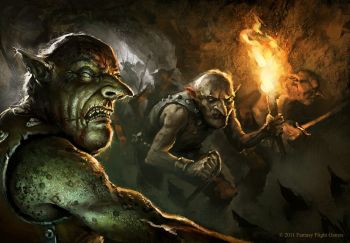Difference between revisions of "Goblin"
Tao alexis (talk | contribs) |
Tao alexis (talk | contribs) |
||
| Line 21: | Line 21: | ||
[[File:Goblin.jpg|left|350px]] | [[File:Goblin.jpg|left|350px]] | ||
| + | == History == | ||
| + | The first goblins were brought into the world through the [[Kodar Gate]] as slaves, first as a part of the hobgoblin ''Fifty Tribes'' and later by [[Norker|norkers]] and [[Xvart|xvarts]]. They were encouraged by these races to increase their numbers, and for this reason were settled in hundreds of slave camps, or gulags, across northern and eastern Asia. For a thousand years, there were tales of goblin clans who escaped to the west, following the Ob River, who were swallowed up by the vast wilderness — or else hunted down and destroyed by hobgoblin war parties. The first settlement of these escaped slaves did not succeed until 663 A.D., with the founding of Gashkura upon a western branch of the Ob River, more than a thousand miles from the hobgoblin frontier. For three centuries thereafter, other settlements were founded, until the goblins were able to form the Magloshkagok kingdom around the large centers of Yobat, Boloine Ob and Istin-gach. | ||
| + | |||
| + | For centuries before and after this period, goblin mercenaries were used throughout the migration period in which Huns, Slavs, Avars and Magyars swept from the east into Europe. During the rise of human cultures resulting from these invasions, the goblins were persecuted and often exiled; in notable cases, such as in Ruthenia (955 A.D.), attempts were made to eradicate the goblins through genocide. These pogroms forced the goblins into the subterranean realm; there, some tribes have not seen the surface in generations, while other clans willingly raid up to hundreds of miles from their lairs, keeping their origin a secret. There is not a part of Europe or Western Asia that cannot count an unknown number of goblin residents among their populations. | ||
| + | |||
See [[Bestiary]] | See [[Bestiary]] | ||
Revision as of 06:44, 10 November 2020
| Species | humanoid (goblinish) |
| No. Appearing | 5–50 |
| Behaviour | clan |
| Range | barrens, subterranean, steppe, taiga, tundra, woodland |
| Size | 4 ft. tall |
| Weight | 52 lbs. |
| Intelligence | 7–9 |
| Armour Class | 6 |
| Hit Dice | 1 |
| Action Points | 4 |
| Max. Stride | {{{stride}}} |
| THAC0 | 20 |
| Hp/Die | d4 |
| Attack Forms | claw or by weapon type |
| Damage | 1–4, varies |
| Special Attacks | infravision |
Goblins are small humanoids with long, sharp ears, leathery greenish skin and an irascible, cringing nature. They possess a rather unpleasant odour to those who are not of the goblinish race, as they have a distaste for washing themselves. Their intelligence is low, which contributes to their unpleasantness. They have but one homeland, a large, sparsely settled kingdom east of the Ural Mountains that they call Magloshkagok that occupies the lower Ob River basin. The region is mostly taiga, muskeg and gravelled tundra, of little value, that became a refuge for goblin slaves who escaped their hobgoblin masters over the centuries. More than two thirds of the world's population of goblins remain slaves inside hobgoblin lands; or else exist in hidden, subterranean clans scattered throughout Eurasia, from China to Iberia.
History
The first goblins were brought into the world through the Kodar Gate as slaves, first as a part of the hobgoblin Fifty Tribes and later by norkers and xvarts. They were encouraged by these races to increase their numbers, and for this reason were settled in hundreds of slave camps, or gulags, across northern and eastern Asia. For a thousand years, there were tales of goblin clans who escaped to the west, following the Ob River, who were swallowed up by the vast wilderness — or else hunted down and destroyed by hobgoblin war parties. The first settlement of these escaped slaves did not succeed until 663 A.D., with the founding of Gashkura upon a western branch of the Ob River, more than a thousand miles from the hobgoblin frontier. For three centuries thereafter, other settlements were founded, until the goblins were able to form the Magloshkagok kingdom around the large centers of Yobat, Boloine Ob and Istin-gach.
For centuries before and after this period, goblin mercenaries were used throughout the migration period in which Huns, Slavs, Avars and Magyars swept from the east into Europe. During the rise of human cultures resulting from these invasions, the goblins were persecuted and often exiled; in notable cases, such as in Ruthenia (955 A.D.), attempts were made to eradicate the goblins through genocide. These pogroms forced the goblins into the subterranean realm; there, some tribes have not seen the surface in generations, while other clans willingly raid up to hundreds of miles from their lairs, keeping their origin a secret. There is not a part of Europe or Western Asia that cannot count an unknown number of goblin residents among their populations.
See Bestiary
